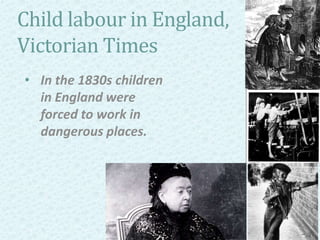
Child labour in our world by Rose.
- 1. Child labour in England, Victorian Times • In the 1830s children in England were forced to work in dangerous places.
- 2. What is social sin? • Social sin is when someone or some people cause harm to a group of people. • It is a result of peoples selfish choices. • In this case it was a group of people and no one attempted to stop them for years.
- 3. What happened? • The Industrial Revolution. • 30.000 children each year. • Children got seriously ill or died. • They weren’t getting paid enough. One of the new steam engine inventions. Children aged 7-18.
- 4. When did it happen and where? • In England. • 1830s. • The Victorian Times (When Queen Victoria ruled).
- 5. Why did people get children to work for them? • Children were small, and could fit into small places that adults couldn’t fit. • Their families were poor and had no other choice but to sent their children to work. • Children were cheap and didn’t expect to get paid much.
- 6. Who was involved? • Most children aged 7-18 who came from lower class families or who were orphans. • The managers of the companies forced them to work or the parents did. • The parents of the children, who got seriously ill or died.
- 7. What could been done differently ? • The managers shouldn’t have employed the kids. • They shouldn’t put the kids in such a dangerous working environment. • When people recognized that factories were doing this to children, they should’ve told the government.
- 8. What happens now and what has changed? • Now children have rights and can choose if they want to work but they can’t leave school until they’re 16. • The United Nations has created a Declaration of Rights for Children throughout the world.
Hinweis der Redaktion
- I did my social sin power point about child labour in the Victorian times, when children were forced to work in factories, coal mines and as chimney sweeps.
- Social sin happens all over the world, its when a single person or a group of people cause suffering or harm to others. Social sin events happen because of peoples selfish decisions by other people. Child labour in England is a example of social sin because a group of people cause suffering to these children and no one tried to stop them.
- Child labour in England happened at the same time as when the Industrial revolution started. The Industrial revelation is when steam engines were invented.30 000 children were employed each year in England.Within the 3 years, most of the kids got seriously ill or died, from being around smoke filled building or falling into the machines.The kids weren’t getting paid enough for all the hours they did
- Child labour happened in England, in the 1830s when queen Victoria ruled known as the Victorian Times.
- Child labour started happening at the time of the industrial revolution, when all the steam engines were invented. With some of the machines you’d have to stick your hands though small places, but adult’s arms were to big. So the people running the companeny must’ve thought it was a good idea to hire children that could squeeze into small openings. Some family were homeless at the time and they had to send them to work because it was their only way to make money and service. Child labour started happening more because children didn’t have as much rights as adults so they didn’t get paid as much. So the managers fired there older empoyese and hired some kids who only get about 3s a week. So their company made more money
- The child were forced to do all there work from age 7-18 so some of these kids didn’t even get to go to school for 2 years.The people that made them work is the factorie managers or their perents people they have no money and that’s their only way of survival.Some parents had no choice but to make there children work because of the government and they they didn’t live much loger because of the terrible working invirnment that caused very serious illness and maybe even death if they fell or got pushed in a machine.
- What could’ve been done differently?They managers shouldn’t have employed the kids and put then in such a dangerous place. If they were to work they should work some where that couldn’t cause harm to them. People shouldve told the government about this because child labour could’ve stopped way before if a group of people stood up to this problem.